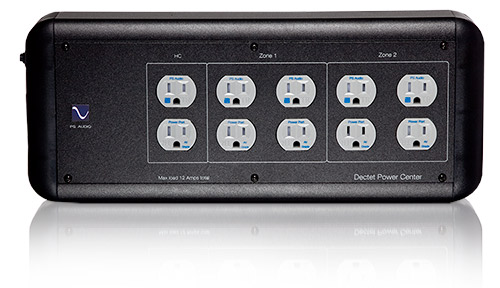What is the Best Surge Protector?

There is a difference between a power strip and a surge protector. A power strip operates like an extension cord, while a surge protector protects your equipment from sudden spikes in the power coming from the street. If all you need is an extension cord, it is still important to choose one that is good quality and will not degrade the power or create noise that will find its way into your audio or video system. As power strips go, it does not get better than a Revolution 2 power strip. This is a well-built product that will do no harm. If you have a high-end audio system and you are using a power conditioner, or if you are using a product that removes noise from the line but you need extra plugs, get the Revolution 2.
Surge Protectors—PS Audio “Dectet” or the “Brick”?
For most people looking to protect their equipment, a surge protector is the smart way to go.
Among surge protectors, the top of the list is a PS Audio Dectet retailing for $500. Considering that it uses 4 PS Audio Power Port Classics retailing for $50 each, paying an extra $300 for the surge protection, and the quality and peace of mind that a PS Audio power product provides, makes this a clear choice when you need a surge protector for power-hungry equipment.
I compared the “Dectet” to a “Brick” which I bought on the recommendation of one of the audio magazines that gave it an award. The Brick retails for $300. Out of the box, I thought the Brick was solid and well-built. It comes with isolated outlets for streaming the power to your component.
Unfortunately, the first time I unplugged a power cord from the Brick, the outlet broke off. The outlets appear to be made of cheap plastic and have more in common with a 49 cent Home Depot outlet than a Power Port Classic.
The company that makes the “Brick” does a terrible job of customer service. When I attempted to contact them to replace the Brick, no one emailed me back. After attempting again and again to contact them, I gave up and used the Brick on another item that required fewer plugs so I could avoid the broken plug.
How a Surge Protector Works
When there is a spike in power coming from the street to the house, or within the house itself, the surge protector diverts the spike into a ground wire. A metal oxide varistor (MOV) diverts the spike so it does not find its way to the expensive items connected to the power line.
MOV’s create a short circuit. When the preset voltage in the unit is exceeded, the MOV directs the extra current away from the items that are plugged into it and toward a ground which absorbs the current. MOV’s have a limited life span. Many people do not understand that surge protectors that use an MOV need to be replaced after a few years. Once installed, they cannot be forgotten.
